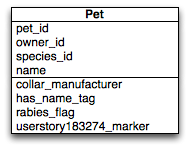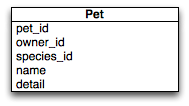Get More Bang for Your Relational Buck
21 May 2013From time to time, your data models might suffer from field creep — you have to keep adding more and more fields to your models to work around edge cases and unique business requirements.
In the world of relational databases, this usually manifests either as additional fields tacked onto an existing table, or a separate “detail” table with a one-to-one relation to its corresponding source model — and these are just the least complicated approaches; there are far more complex ways to address the situation!

One approach to addressing the need for ever-more-specific-use-case fields: add more (increasingly ridiculously-named) fields to the table.

An alternate approach: move all of those pesky “detail” fields into a separate table that you can hide away in the closet whenever company comes over.
In addition to cluttering up your ERD, you are also leveraging the power (and overhead!) of your relational database engine for things that don’t actually need it.
Your pet store application might never need to filter a select query by userstory183274_marker value, but thanks to user story 183274, you still have to store that information with each pet.
Perhaps there’s another approach, one that is more scalable and doesn’t clutter up your database tables with (almost) useless fields… and yet still makes this custom information accessible to your application.
Well, as it happens, there is! Combine all of those extra “detail” fields into a single detail field that uses – you guessed it – JSON to store key/value pairs!

Much easier on the eyes!
Let’s peek at some values in our newly JSON-ified Pet table:
| pet_id | owner_id | species_id | name | detail |
|---|---|---|---|---|
| 1 | 1 | 1 | ‘Bowser’ | {"collar_manufacturer": "PetProtector", "rabies_flag": true} |
| 2 | 1 | 2 | ‘Oliver’ | {"has_name_tag": false, "music_preference": "Light Jazz"} |
| 3 | 2 | 1 | ‘Marcus’ | {"userstory183274_marker": "FILENOTFOUND"} |
Notice that in the time it took to draft up this table, we added a new feature: Musical Preference. Oliver likes Light Jazz.
Some of the benefits of storing “extra” data about your models this way:
- You can add additional properties without having to alter your database schema.
- Keeps your database schema tidy; only “essential” fields show up in your tables.
There are a few costs to this approach that you should be aware of, however:
- It requires additional application logic to encode/decode the JSON in the detail field. This has implications both for performance and development time.
- These fields are not indexable! If you need to search/filter by a property in a detail field, you will need to move it to its own column in the database table or use a system such as Lucene to index and search that value.
- Extracting data from a detail field is an all-or-nothing operation; you have to pull the entire JSON string from the database and decode it in your application to find a specific property. This is usually not an issue for modern ORMs, since all columns are usually automatically pulled in every time they fetch a record from the database.
For storing one-off properties and flag values that you only need at the application level (i.e., you do not need to index/filter/search these values), think about whether you can store these values in a single JSON-formatted string instead of bloating your tables with extra fields.
And if you find that you’re using this feature a lot in your relational-database-powered application, you might want to consider whether a NoSQL solution such as CouchDB is a better fit for some or all of your data!